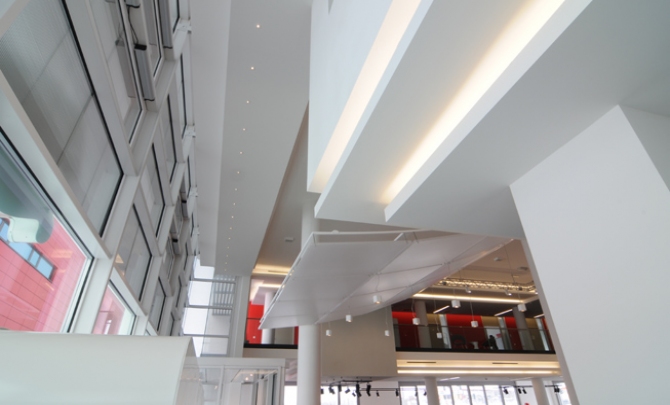Sounds good: Toptec Akustic
In the autumn of last year, Puma employees moved into the new group headquarters building in Herzogenaurach. The Kaiser company in charge of the dry construction work gave the ceilings of this big project an attractive appearance with the acoustic plaster system by Vogl Deckensysteme. The plaster lining was applied by Markus Piccolini.
Many will know Herzogenaurach for the sports equipment companies based there. In the same town, the global player Puma moved into their new building last autumn. It consists of three main bodies. The company makes use of the ideal traffic connection to the A3 autobahn, connecting Bavaria to the west of Germany. On 08/11/2007, the symbolic first cut of the spade was made by the Bavarian minister-president Günther Beckstein. Now, the finished complex covers an area of almost 50,000 m². The Puma Plaza was planned by architect Klaus Krex (conceptual design and application for the planning permission) by the Nuremberg architecture team da capo al fine, and the Nuremberg team of Böhm Architekten; Nuremberg, who were in charge of the factory planning.
Ecology plays a major role
The mammoth complex consisting of three buildings helps the company to attract attention as a trademark, but also to present itself as a successful lifestyle company. 700 employees work at the site. The building complex consists of the seven-storey administrative building, a four-storey brand centre and the retail building. The brand centre accommodates the corporate congress centre where there is space for 1,500 people in a multimedia hall and several event rooms. In the future, it will also serve as a venue for customer presentations and meetings. The retail building of 2,700 m² on three storeys is adjacent to that complex. It constitutes an extremely clear, rectangular form. Its red façade made of aluminium compound panels represents a PUMA shoebox. Inside, the PUMA concept store and the factory outlet centre are located. Here is where the customers can buy "their" Puma products. A merchandising centre and a restaurant have also been integrated.
In architecture, different standards apply today as compared to a few years ago. Due to the climate change calls for sustainable and ecological thinking. In this case, the architecture firm relied on a state-of-the-art concrete core temperature control system as the most important energy measure for this building. It ensures ecological basic heating and cooling in the three buildings. Moreover, photovoltaic systems were installed on the roof of the retail building and on the southern front. They take up 1,000 m² and are to cover the complete energy supply for the company.
If you consider the building complex in its entirety, it is dominated by its rectangular form. The extensive building group with its transparent glass façade still blends harmoniously into the surrounding landscape.
For the interior design of the ceilings a sound-absorbing acoustic plaster ceiling was chosen. The project manager Derfuß from the Kaiser company in Erlangen was responsible for the dry construction work. The plaster application was perfomed by the specialist Markus Piccolini from St. Johann (Lonsingen). Lepas and light channels were integrated in the ceiling go give the celling instllation an appealing design.
Type of object: Office
Vogl products: VoglToptec Acoustic Plaster System
Size: Approx. 4,500 m²
Drywall contractor: Markus Piccolini, St. Johann (Lonsingen)
Photographer: Thilo Jaeckel
Completion: 2009
Architects: Klaus Krex (conceptual design and application for the planning permission), da capo al fine Architekten Team, Nuremberg
Architect: Böhm (factory planning), Nuremberg
Perfect acoustics - thrilling light channels
On a surface of almost 4,500 m² VoglToptec acoustic plaster system panels in the version 12/25 square perforation were used. The plasterboard system panels backed with black acoustic fleece have a perforated area of 22.9%. The product manager Benedikt Roos explains: "Following the priming and subsequent wallpapering of the ceiling with the plaster base fleece, the white acoustic plaster Nano SF is machine-applied in three time-lagged operations until an approx. 3-mm-thick, open-pored plaster is achieved." The plus of the VoglToptec acoustic plaster system is its reliability of application. The ultimate advantage ist the components are perfectly harmonised. From the ceiling framework to the finish: screw kit, super primer, special adhesive, plaster base fleece and acoustic plaster from the VoglToptec system!
In order to create contrasts in the room design, several variants suggested themselves for this ceiling structure. Ceiling leaps and light channels underline the room ambience. The intention is that the light elements give a special radiation to the room-closing elements and to direct the light in such a way that the observer is gently guided through the rooms.
All in all, the Vogl products offer optimised ceiling solutions for every installation situation, with the highest requirements on aesthetics, sound absorption and form design. Due to their edge-to-edge mounting, they guarantee best processing and reliable results. The absolute plus: The tedious filling of the joints and screw heads becomes superfluous! This results in considerable time saving for the dry construction contractor thanks to Vogl ceiling solutions. Moreover, a real estate becomes more valuable and its usefulness more sustainable through form, colour and function!
zurück

















